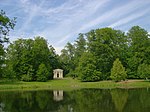Friedenstein Palace

Friedenstein Palace (German: Schloss Friedenstein) is an early Baroque palace built in the mid-17th century by Ernest I, Duke of Saxe-Gotha at Gotha, Thuringia, Germany. In Germany, Friedenstein was one of the largest palaces of its time and one of the first Baroque palaces ever built. Friedenstein served as the main seat of the Dukes of Saxe-Gotha and later as one of the residences of the Dukes of Saxe-Coburg and Gotha, closely linked with the royal family of Great Britain through the marriage of Queen Victoria and Prince Albert. The final two ruling Dukes were both princes of the United Kingdom. The palace complex today houses several museums. It is also notable for hosting the Ekhof-Theater, one of the oldest theatres in operation in Germany, still featuring the original Baroque machinery for changing the scenery.
Excerpt from the Wikipedia article Friedenstein Palace (License: CC BY-SA 3.0, Authors, Images).Friedenstein Palace
Elsa-Brändström-Weg,
Geographical coordinates (GPS) Address Nearby Places Show on map
Geographical coordinates (GPS)
| Latitude | Longitude |
|---|---|
| N 50.945833 ° | E 10.704444 ° |
Address
Schlosskirche
Elsa-Brändström-Weg
99867 , Gotha Nord
Thuringia, Germany
Open on Google Maps










